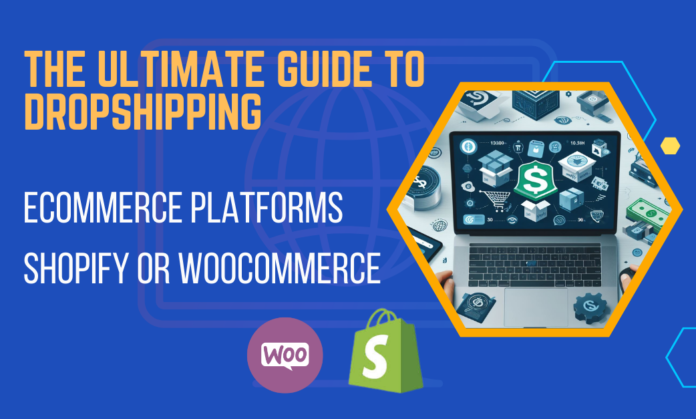In the rapidly evolving world of ecommerce, understanding dropshipping, choosing the right ecommerce platform, and implementing effective strategies are crucial for building a successful online store. This comprehensive guide explores these topics in detail, providing valuable insights, recommended resources with URL links, and answers to key questions.
Understanding Ecommerce Platforms: Shopify vs. WooCommerce
Shopify:
Shopify is a popular hosted ecommerce platform that empowers entrepreneurs to create and manage online stores without technical expertise. Key features include customizable templates, built-in marketing tools, secure payment gateways, and 24/7 customer support. Shopify is ideal for beginners due to its user-friendly interface and comprehensive ecosystem of apps and integrations.
WooCommerce:
WooCommerce is a WordPress plugin that transforms any WordPress website into a fully functional ecommerce store. It offers extensive customization options, flexibility, and scalability. WooCommerce is suitable for businesses seeking full control over their online presence and requiring advanced features.
Choosing Between Shopify and WooCommerce:
- Shopify Benefits:
- All-in-one solution with hosting included.
- Easy setup and user-friendly interface.
- Reliable customer support available 24/7.
- Comprehensive app store for additional functionalities.
- Secure payment gateways for seamless transactions.
- WooCommerce Use Cases:
- Ideal for businesses already using WordPress.
- Offers complete customization and flexibility.
- Extensive range of WordPress themes and plugins.
- Scalable solution for businesses with unique requirements.
Understanding Dropshipping: Benefits and Drawbacks
What is Dropshipping?
Dropshipping is a retail fulfillment method where a store doesn’t keep the products it sells in stock. Instead, when a store sells a product, it purchases the item from a third-party supplier and has it shipped directly to the customer. The seller doesn’t handle the product directly, minimizing inventory costs and logistical challenges.
Why Dropshipping?
- Low Startup Costs: Minimal investment required to start an online store.
- No Inventory Management: Eliminates the need for warehousing and stock management.
- Wide Product Selection: Access to a vast range of products without purchasing inventory upfront.
- Scalability: Ability to test multiple products and niches quickly.
Benefits of Dropshipping:
- Low Financial Risk: No need to invest in inventory upfront.
- Flexibility: Operate from anywhere with an internet connection.
- Easy to Start: Minimal setup required compared to traditional retail models.
- Diverse Product Range: Access to a global network of suppliers and products.
Drawbacks of Dropshipping:
- Lower Profit Margins: Prices are typically higher than wholesale due to supplier costs.
- Inventory Issues: Reliance on third-party suppliers for product availability and quality.
- Shipping Delays: Limited control over shipping times and customer experience.
- Supplier Challenges: Dealing with supplier communication and potential stock issues.
Top 20 Dropshipping Suppliers
- AliExpress: A global marketplace offering a wide range of products at competitive prices.
- Alibaba: A wholesale platform connecting buyers with suppliers worldwide.
- SaleHoo: A wholesale directory providing access to verified suppliers and market research tools.
- Worldwide Brands: A comprehensive directory of certified dropshipping companies and wholesalers.
- Doba: A dropshipping platform offering access to millions of products from vetted suppliers.
- Sunrise Wholesale: Specializes in dropshipping home and garden products, electronics, and more.
- Wholesale2b: Provides access to a diverse catalog of products sourced from multiple suppliers.
- Megagoods: Focuses on dropshipping consumer electronics and video game products.
- Wholesale Central: A comprehensive directory of wholesale suppliers across various categories.
- Modalyst: Specializes in fashion and lifestyle products, connecting businesses with US and European suppliers.
- Spocket: A dropshipping marketplace connecting sellers with US and European suppliers for fast shipping.
- CJDropshipping: Offers a wide range of products with fulfillment services tailored for dropshippers.
- CROV: Connects buyers with suppliers offering a diverse selection of dropshipping products.
- Inventory Source: Automates product listing and inventory management for dropshippers.
- Printful: Specializes in print-on-demand dropshipping for custom-designed merchandise.
- Oberlo (now part of Shopify): Simplifies product sourcing and order fulfillment for Shopify stores.
- Dropified: Automates dropshipping tasks, including product sourcing and order processing.
- Wholesale Deals: A UK-based wholesale directory offering dropshipping opportunities.
- SaleSource: Provides product research tools and access to dropshipping suppliers.
- DSM Tool: Assists with product sourcing and dropshipping management.
Comparing Shopify with TikTok Shop and Amazon Shop
Shopify vs. TikTok Shop: Shopify provides a dedicated platform for ecommerce with extensive customization options and integrated marketing tools. TikTok Shop integrates with the TikTok app for seamless social commerce, leveraging TikTok’s user base for product promotion.
Shopify vs. Amazon Shop: Shopify enables businesses to build their branded online store with full control over pricing and customer relationships. Amazon Shop leverages Amazon’s vast customer base but requires adherence to Amazon’s rules and fees, with limited brand control.
Leveraging Digital Marketing and SEO for Store Success
Digital Marketing Strategies:
- Social Media Marketing: Utilize platforms like Facebook, Instagram, and TikTok for product promotion and customer engagement.
- Influencer Partnerships: Collaborate with influencers to reach a wider audience and increase brand visibility.
- Email Marketing Campaigns: Build and nurture customer relationships through targeted email campaigns.
- Content Marketing: Create valuable content such as blogs, videos, and guides to attract and educate potential customers.
SEO (Search Engine Optimization) Strategies:
- Keyword Optimization: Research and incorporate relevant keywords into website content and product descriptions.
- On-Page SEO: Optimize meta tags, headings, and URLs for search engines.
- Off-Page SEO: Build quality backlinks from reputable sources to improve search engine rankings.
10 Key Points for Building a Successful Online Store
- Identify a Profitable Niche: Research and choose a niche with demand and growth potential.
- Select the Right Ecommerce Platform: Choose an ecommerce platform that meets your business needs and technical expertise.
- Optimize Website for Mobile Users: Ensure your website is responsive and user-friendly on mobile devices.
- Offer a Seamless Checkout Experience: Simplify the checkout process to minimize cart abandonment.
- Source Reliable Dropshipping Suppliers: Partner with reputable suppliers to ensure product quality and timely delivery.
- Implement Effective Digital Marketing Strategies: Utilize social media, email marketing, and SEO to drive traffic and conversions.
- Provide Excellent Customer Service: Build trust and loyalty by offering responsive customer support.
- Focus on Product Quality and Branding: Differentiate your store with high-quality products and compelling branding.
- Monitor and Optimize Store Performance: Use analytics to track sales, traffic, and customer behavior to make informed decisions.
- Stay Informed and Adapt to Market Trends: Keep up with industry trends, consumer preferences, and technology advancements to stay competitive.
Handling returns in dropshipping can vary depending on the supplier and the arrangement you have with them. Here are common practices for how dropship suppliers typically handle returns:
- Return Policies: Dropship suppliers often have their return policies that outline the terms and conditions for returns. These policies can vary in terms of return window (e.g., 30 days), acceptable reasons for returns (e.g., defective items, wrong items shipped), and requirements for returning the product (e.g., unused condition, original packaging).
- Communication: When a customer wants to initiate a return, the dropshipper should be contacted first. This may involve reaching out directly to the supplier or communicating through the dropshipping platform used.
- Return Authorization: Suppliers may require customers to obtain a return authorization number or approval before sending back the product. This helps ensure that the return is legitimate and meets the supplier’s criteria.
- Return Shipping: Depending on the supplier’s policy, the customer may be responsible for covering the cost of return shipping. In some cases, the supplier may provide a prepaid shipping label for the return.
- Refunds or Replacements: Once the returned product is received and inspected by the supplier, they will typically process a refund to the customer’s original payment method or arrange for a replacement product to be shipped out.
- Restocking Fees: Some suppliers may charge restocking fees for returned items, especially if the return is not due to a defect or mistake on the supplier’s part. The restocking fee helps cover the costs associated with processing the return and making the item available for resale.
- Quality Control: Dropship suppliers may have processes in place to inspect returned items to determine if they can be resold. This ensures that only acceptable products are returned to inventory.
It’s essential for dropshippers to familiarize themselves with the return policies of their suppliers and clearly communicate these policies to their customers. Providing excellent customer service during the returns process can help build trust and satisfaction with your brand, even in a dropshipping business model.
Frequently Asked Questions (FAQs) About Dropshipping
1. What is Dropshipping?
- Dropshipping is a retail fulfillment method where the seller (dropshipper) does not keep products in stock. Instead, when a customer places an order, the seller purchases the item from a third-party supplier who then ships it directly to the customer.
2. How Does Dropshipping Work?
- The dropshipper lists products for sale on their online store without owning inventory. When a customer buys a product, the order and shipment details are forwarded to the supplier, who then fulfills and ships the order directly to the customer.
3. What are the Benefits of Dropshipping?
- Some key benefits of dropshipping include low startup costs, no inventory management, access to a wide range of products, flexibility to test multiple products and niches, and the ability to operate from anywhere with an internet connection.
4. How Do I Find Dropshipping Suppliers?
- Dropshipping suppliers can be found through online directories, wholesale marketplaces, and by reaching out to manufacturers directly. Popular platforms like AliExpress, SaleHoo, and Worldwide Brands are great starting points for finding reputable suppliers.
5. What Products Can I Dropship?
- Virtually any product can be dropshipped, but successful dropshippers often focus on niche products with high demand. Common dropshipping product categories include apparel, electronics, home goods, and beauty products.
6. How Do Dropship Suppliers Handle Shipping and Delivery?
- Dropship suppliers are responsible for packaging, shipping, and delivery of orders to customers. They often offer multiple shipping methods and may provide tracking information for orders.
7. How Do Dropship Suppliers Handle Returns and Refunds?
- Dropship suppliers have their own return policies which outline the terms and conditions for returns. Customers typically contact the dropshipper to initiate a return, and the supplier will process refunds or replacements based on their policies.
8. What Are Some Challenges of Dropshipping?
- Dropshipping challenges can include lower profit margins compared to traditional retail, reliance on suppliers for inventory and shipping, potential shipping delays, and managing customer expectations.
9. Is Dropshipping Profitable?
- Dropshipping can be profitable with careful planning, product selection, and marketing strategies. Success often depends on finding reliable suppliers, identifying profitable niches, and providing excellent customer service.
10. How Can I Start a Dropshipping Business?
- To start a dropshipping business, you’ll need to choose an e-commerce platform, source reliable suppliers, set up your online store, list products, and implement marketing strategies to attract customers.
Conclusion: Building Your Successful Online Store
Building a successful online store requires careful planning, strategic execution, and continuous optimization. By leveraging the insights shared in this guide—from choosing the right ecommerce platform and dropshipping suppliers to implementing effective digital marketing strategies and focusing on customer satisfaction—you can set your ecommerce venture on the path to success.











